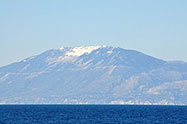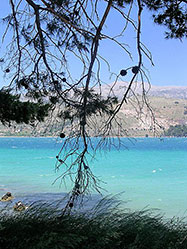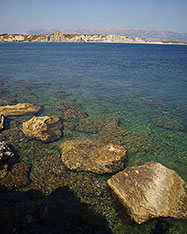
√ Kefalonia wildlife |
The rugged coastline of Kefalonia with its many beaches and coves
|
 |
Kefalonia, the largest island of the Ionian Sea, is considered one of the most beautiful Greek islands for the richness, variety and harmony of its natural beauties. A perfect mix of sea, beaches, mountains, verdant plains, flora and fauna. The island is ideal for a direct contact with nature, in the sense of both naturism and nudism! The coast of Kefalonia is quite varied, offering powerful contrasting landscapes. Stretches of sandy beaches on shallow crystal waters, white pebbles, large and small creeks (many still unexplored) offering the best Greek beaches, among the best in the world. Just to remember few of them: Myrtos Beach and the beautiful natural surroundings of Skala, Antìsamos, Makrìs Yalòs, Xi, Ammes, Avithos, Lourdàs and Koutsoupià. Furthermore, there are also naturist beaches in Kefalonia, including: Agios Sissios - Antisamos - Trapezaki - Koroni - Platia Ammos. The mountainous highlands dominate all the other Ionian islands extending from Cape Dafnoudi to the extreme south of Cape Mounda, where we find the most important mountain called Enos. The few and small plains of the island are in the area of Krania, Omalon, Sami, Pilarou, Livathou and Palikis. Mount Enos reaches, to the highest peak (Soros), the altitude of 1628 meters thus being the second heighest mountain on Greek islands. It is also one of the ten National Greek Parks, a refuge for migratory birds and mammals, the ideal habitat for rare species of flowers, shrubs and herbs. Its slopes are covered with trees of a dark green species that grows only here (abies cephalonica). The Kefalonia Fir Tree There was a time when Mount Enos was rich in forests of Kefalonia Abies, the Kefalonia fir, which grows above 800 meters. At a glance it looks like a black forest, with dark green leaves, which led the Venetians to call the Ainos mountain chain "Black Mountain". The forest still exists, but it has been devastated over the centuries by the timber trade and the forest fires. This tree is endemic to the area, but it can be also found on most of southern greek hills. From this tree it can obtained a very valuable wood, that was highly demanded to build the old wooden ships. No coincidence that the columns of Knossos in Crete were created by the fir trees of Kefalonia. Over the centuries, the timber trade from Kefalonia has been intesified, thanks to the fact that the woods of firs were accessible and close to the sea, and then easily shipped. In addition, also forest fires have played a significant role in devastating these forests. In 1962 the area was declared a National Park in order to protect this species of fir trees, of which islanders are proud of. The shape and the limestone stratification of Kefalonia determines the presence of important geological phenomena all over the island (such as the corrosion of the limestone that gives life to caves, abysses, etc.). Particularly interesting are the caves of Melissani Agalaki, Saint Theodoron, Zervati, Drogarati, Sakou. These geological phenomena are are very interesting especially with regard to the behavior of waters. Not by chance that Kefalonia has been called the island of the "bizarre", because of its numerous and unusual natural phenomena, such as moving rocks, waters that disappear, strange flowers and more. The Katavothres (or Thalassomilos) is a rare geological phenomenon for which the sea water pours through the cracks in the rocks near the shore and disappears underground. Also known as the phenomenon of "sinking holes", the Katavothres can be observed at 2.5 km from Argostoli, near the sea mills, whose carsic holes swallow the water that disappears into the ground. The research revealed that the same water that disappears at Katavothres in Argostoli, flows near the village of Karavomilos at Sami, forming an almost circular lake of fresh water, then flowing into the sea in the bay of Sami. In the Melissani Cave the most part of the roof has collapsed throughout the years because of the numerous earthquakes (the last one in 1953) creating a slope so that waters of Karavomilos form a large lake in the cave. In its deepest point, Lake Karavomilos is 32 meters deep and is well know for its crystal clear waters and the changing shades of blue and green that can be observed in different moments of the day. Another geological phenomenon is called Kounopetra (the moving stone). It is a large monolithic rock with a circumference of 20 meters that juts out into the sea. It is located in the western part of the island at Paliki, near the village of Manzavinata. The phenomenon, unique in the world, consists of a rhythmic and continuous movement of the rock, from east to west, about 20 times per minute. The phenomenon, visible from the sea or while standing on the rock, has weakened in the lsat decades until the earthquake of 1953 that has slipped the rock providing stability. The Flora Flowers abound in Kefalonia, especially in the spring, from the omnipresent brooms to the poenie and some rare species of wild orchids, but the best time to see them is from late March to April and May, although the season lasts longer in the upper part of Mount Ainos. This area of the mountain, now protected as national park, offers a great variety of protected species like the endemic fir, Abies Cephalonia. The orchids stand out in the spring in about 31 different species. Despite the heat and lack of water during the summer, there are always flowers to observe, like the beautiful marine Narcissus (Pancratium maritimum) and the mullein. Autumn rains give vigorous life to the crocus and to the cyclamen with a new flush of long lasting flowers, coloring the winter until the arrival of spring. The Fauna The fauna is surprisingly rich here and the island has a variety of wildlife including foxes, hares, weasels, martens and hedgehogs. The latter is most likely to be met so that people sometimes can not cross the road safely. Wild horses are common on the sides of Mount Ainos, but the sightings are rare. The land turtles are too many and they are often seen on the side of the road. Snakes are also very numerous, but they are mostly harmless. A rare and protected species of seals live on the rugged and inaccessible shores of the island. Of particular note are two phenomena affecting animals of the island. Near the mountain "Agia Dynati" some goats and rabbits have golden or silver teeth, because of the composition of the soil. Another rarity is about the goats on the island - according to the historian Claudio Eliano, goats could survive without water for six months, only living of the moisture fo the breeze. This has been confirmed by modern pastors. The Monk Seal The sea between Kefalonia and Ithaca appears to be the natural habitat of the rare monk seal, in danger of extinction, and that thrives in the warm waters of the Mediterranean and the Atlantic, off the coast of North Africa. Mentioned by Homer, seals were far more prolific in the ancient world, losing in the last centuries the classic breeding habits and being repeatedly threatened by fishermen. This rare and shy animal shelters in caves and remote places to hide from men and to give birth to a seal pup (that is usually just one puppy). The development of tourism along the coast and the increasing leisure activities around the sea shores have seriously interfered with the usual gatherings of the species. The monk seal lives of fish and octopus, but the progressive scarcity of food led to serious conflicts with fishermen. Too many times in the past, the conflict was resolved by simply killing the seals, especially when it was accidentally trapped in the nets. Now the focus is on the conservation of the species with many active groups supporting the project to protect the small population of seals that live around Cephalonia, Ithaca and Lefkada. Caretta-Caretta The Caretta-Caretta (or Caretta turtle) is a rare sea turtle that lives in the Mediterranean Sea, and particularly along the coasts of Kefalonia and Zakynthos. They can grow to considerable size, with a weight up to 140 kg. Despite their size, these turtles can swim very fast, thanks to their large and rigid flippers on the front and to the rear. However, on the mainland they become extremely vulnerable and slow because, unlike other turtles, the Caretta-Caretta turtle can not retract into its carapace to hide. Caretta-Caretta turtles always breed on the same beach where they were born, and for this reason it is important that the nesting beach is kept as untouched as possible. The nesting period is from June to August, when the female of the species makes its way to the beach to lay eggs. The female explores the land by controlling the distance from the sea, the temperature and quality of the sand, in order to choose a suitable place to lay eggs. Once the choice is made the turtle digs with its fins a couple of feet deep hole, where to lay its eggs. Eggs are small and soft and do not break when dropped into the hole. The nest contains about 120 eggs that hatch usually 50 days after the laying. Eggs are protected by the sand and kept warm by the sun. Usually about 60% of all eggs hatch and young turtles move towards the sea following the horizon and the refelction of the moonlight on sea. Only a small percentage survive - the physical obstacles on the beach and the lights of restaurants and bars often confuse young turtles. Once in the water the little turtle will meet even greater dangers with only one in a thousand that will reach adulthood. Some of the beaches of Kefalonia are highly protected during the breeding season of the turtle, including Mounda Beach near Skala, Trapeazaki Beach, Minies Beach and the area near the airport. There is a non-profit organization based in Katelios that works to preserve this species in danger of extinction. |
The mount Enos |
 |
|
The Kefalonia fir, that can be found both on mountains and on the seashore |
 |
|
The geological phenomenon of Katavothres at the seamills of Argostoli
|
 |
|
The Drogarati cave has many stalactites and stalagmites
|
 |
|
The area of Kounopetra
|
 |
|
The lake and the cave of Melissani
|
 |
|
Caretta-Caretta: Kefalonia sea turtles
|
 |
|
about us | sitemap | advertising | contacts | disclaimer | links |